
Something goes boom in the night: the explosion of a Cold War secretby Dwayne A. Day and Asif Siddiqi
|
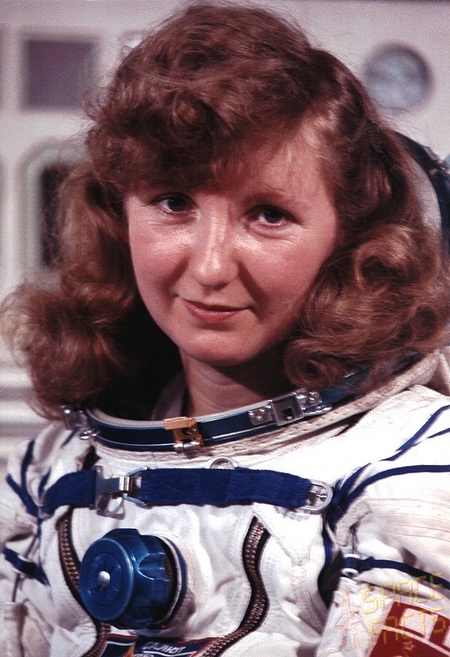 Irina Pronina was scheduled to fly on a Soyuz mission in 1983 and would have been the third female Soviet cosmonaut, but was removed because of objections from a senior official. She never flew in space. (credit: Spacefacts.de) |
By the early 1980s, while the United States was starting to launch its Space Shuttles, the Soviets had settled comfortably into a program of successive space stations known as Salyuts. In 1982, the Soviet Union launched the Salyut-7 station, the centerpiece of its crewed space program. The first long duration crew to the station, known as “EO-1,” (Ekspeditsii osnovnyye or Primary Expedition) spent nearly eight months aboard Salyut-7 in 1982, setting a new record for a long duration mission, 211 days.
Following this success, 1983 was planned to be a banner year, with two Primary Expeditions, EO-2 and EO-3, which would involve for the first time ever a hand-off from one crew to another in space, so that the station would be continuously crewed the entire year. EO-2 would be launched in late March to begin a 90-day flight. In late June, EO-3 would lift off and dock with Salyut-7 with about a week of overlap with the EO-2 crew who would then return to Earth. The EO-3 crew would then spend about six months in space and return to Earth in December.
| 1983 was planned to be a banner year, with two Primary Expeditions, EO-2 and EO-3, which would involve for the first time ever a hand-off from one crew to another in space, so that the station would be continuously crewed the entire year. |
Each of these two missions would break new ground. The three-person EO-2 crew would include two men, rookie cosmonaut Vladimir Titov (commander) and veteran Gennadiy Strekalov (flight engineer), but also a woman, 30-year old Irina Pronina, an engineering graduate of the elite Bauman Higher Technical School in Moscow, who would be the third Soviet woman in space. If all went well, Pronina would carry out the first long-duration flight—roughly three months—of a woman in space. In addition, Titov and Strekalov were trained to carry out a daring spacewalk in the summer to attach additional solar panels to Salyut-7. Among the supply visits planned to the station was that of a massive Transport-Supply Ship (TKS), a leftover module from the military Almaz space station, which would arrive in early March.[1]
The subsequent EO-3 crew would include veteran Vladimir Lyakhov (commander), rookie Aleksandr Aleksandrov, and another veteran, Aleksandr Serebrov. During their lengthy flight, they would receive a visiting mission late in the year, known as EP-3-1 (for Ekspeditsii poseshcheniya or Visiting Expedition). This flight would include Leonid Kizim, Vladimir Solovyev, and, for the first time, a cosmonaut training for the Soviet space shuttle Buran, a decorated civilian test-pilot named Igor Volk. The idea was for Volk to gain some short experience in space conditions before commanding the first crewed mission of Buran. It was no doubt an ambitious plan for the year.
Things got off to a promising start. The large automated TKS—under the cover name Kosmos-1443—successfully docked with Salyut-7 in March 1983 bringing the total mass of the orbital station to 40 metric tons. The TKS brought 2.78 tons of supplies for future crews including the personal effects of Irina Pronina.
Unfortunately for Pronina, she would never see these items. About a month before her planned launch, she was pulled from the crew. The reason? A high-ranking defense official, reportedly Minister of Defense Dmitriy Ustinov, objected to a woman on a long-duration space crew. There were also rumors that higher-ups were displeased by her recent divorce from her second husband. Despite the vigorous advocacy of Valentin Glushko, the head of giant space firm NPO Energia, the last-minute decision prevailed: Pronina was pulled from the crew and replaced by a man. In her place came veteran cosmonaut Aleksandr Serebrov who had literally just flown in space on the previous Soviet launch, Soyuz T-7. The new crew needed a little bit of extra time to train, delaying the launch of EO-2 by about a month. Pronina would never fly in space, although rumors about her would circulate for years.
All of this was not a good portent of things to come. When the new EO-2 crew—Titov, Strekalov, and Serebrov—took off on April 20, 1983, in their Soyuz T-8 spacecraft, they immediately ran into trouble. The crew found that their Igla rendezvous antenna did not deploy to its full extent, severely mitigating their ability to approach and dock with the Salyut space station. Despite several attempts at a manual docking, the crew were unable to link up with the Salyut and returned to Earth after a short two-day mission.[2]
In determining how to move ahead, Soviet planners devised a repeat attempt to try to board the station, but split the new mission into two parts, EO-2-1 and EO-2-2. The former would last 50 days and the latter 100 days. Once again, the missions were planned so that for the first time in the history of Soviet stations—and indeed the history of space exploration—one crew, EO-2-1, would hand over the station to the next one, EO-2-2. These crews were pared down to two men each instead of three, partly to conserve resources on Salyut-7: EO-2-1 would include Lyakhov and Aleksandrov without their Buran cosmonaut colleague. EO-2-2 would include Titov and Strekalov, quickly cycled back into the rotation and obviously cleared of any fault for the Soyuz T-8 failure.
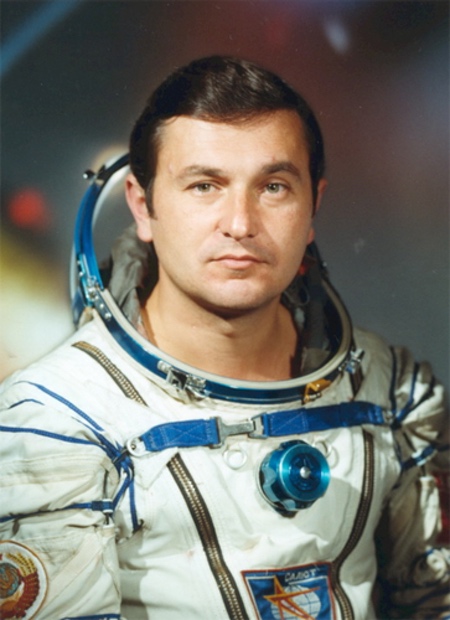 Vladimir Titov was one of the cosmonauts on the ill-fated Soyuz T-10 mission, which experienced an on-pad abort after the Soyuz rocket caught fire. He and Gennady Strekalov were saved when their launch abort system carried them away from their exploding rocket. Their Soyuz spacecraft landed several kilometers from the launch pad and was later observed on the ground by an American reconnaissance satellite. (credit: Wikimedia Commons) |
With the new plan in place, on June 27, 1983, the Soyuz T-9 crew of Lyakhov and Aleksandrov (EO-2-1) lifted off to dock with the Salyut station. Once again, trouble struck: one of the Soyuz’s solar panels failed to deploy. Fortunately, through a quickly formulated backup plan using less than optimal energy, the crew were able to rendezvous and dock with the Salyut-7 station. The total mass of the orbital stack (Soyuz T-9 + Salyut-7 + TKS) was a whopping 47 tons. The new crew had a lot of work on their plate as they unloaded the new add-on TKS module that was linked to the station.
| About six hours before launch, in a tradition he started on his two prior space missions, Strekalov called home to talk to his mother who apparently had had a bad dream about the mission. Something dreadful would happen, she feared. |
The next crew meanwhile continued to prepare for the 100-day mission known as EO-2-2. Having been on the failed attempt to dock with the station in early 1983, they were now doubly motivated to succeed. They were also the best trained in the cosmonaut corps to carry out an EVA to add extra solar panels to Salyut-7. Commander Vladimir Titov, 36 years old, was a skilled Air Force pilot with 1,300 hours logged in various aircraft including high-performance MiG and Sukhoi jets. His flight engineer, Gennady Strekalov, 42, was an engineer at NPO Energia, the design firm responsible for the Soyuz and Salyut stations, and a veteran of two space missions.
The original plan was to launch the EO-2-2 mission in early August, but there was a six-week delay as NPO Energia ran an extra set of tests to make sure that the Soyuz spaceship was in good shape due to the failed deployment of the solar panel on the previous mission. The new launch date was set for the night of September 26, 1983, precisely at 2337:51 Moscow Time. The mission would be called Soyuz T-10 and would use Soyuz-T vehicle no. 16L. A new Soyuz-U rocket was rolled out, vehicle Yu15000-363. The cosmonauts had the call-sign Okean (“Ocean”).
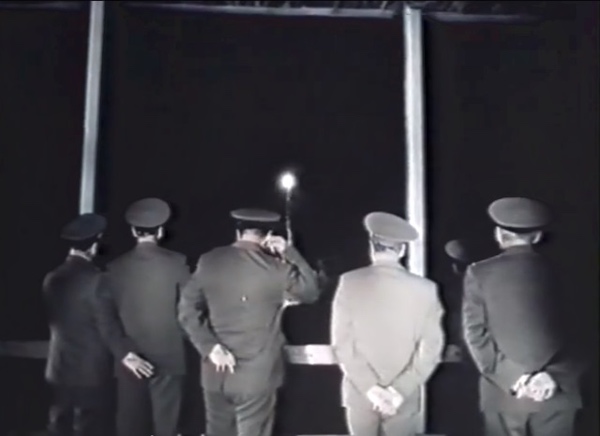 Military officers watching as the launch escape system fires and pulls the Soyuz spacecraft clear of the burning rocket in September 1983. (credit: Wikimedia Commons) |
The events leading up to the launch were uneventful, although flight engineer Strekalov remembers having a bad feeling. About six hours before launch, in a tradition he started on his two prior space missions, he called home to talk to his mother who apparently had had a bad dream about the mission. Something dreadful would happen, she feared. Strekalov reassured her and hung up, but his uneasiness remained.[3]
As night fell at Baikonur, the temperature dropped from a daytime 27°C (81°F) to 10°C (50°F). Winds were a bit high for that time of the year, with gusts of 43 kilometers an hour (27 miles per hour).[4] As the minutes and seconds ticked down for the nighttime launch, everything seemed fine. Titov remembers that at about a minute before launch, there was suddenly a surge in vibrations (3.4 seconds long), followed by a short interval of calm lasting about 4 seconds, and then another more powerful wave of vibrations “as if the rocket was going to blow up,” in Strekalov’s words. Things in the Soyuz cabin were clanging around as the cosmonauts were rudely jerked around.
What neither man realized was that their fully-fueled rocket was on fire.
From the perspective of those watching, things seemed to go wrong about a minute before the planned launch when an unusual reddish-yellow flame began to rise around the rocket, followed by black smoke. Journalist Mikhail Rebrov who was there to watch the launch remembers a multitude of colors—the smoke turned yellow, red, black, orange— and rose almost to the top of the rocket.[5]
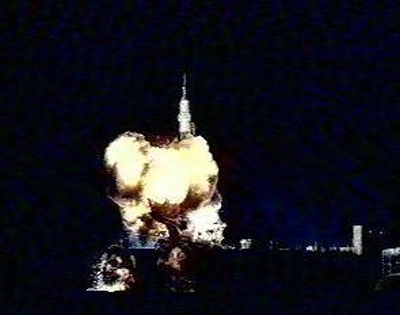 The Soyuz rocket caught fire while on the pad and a manually-operated launch escape system fired seconds later, saving the crew. (credit: Soviet archival film) |
In the spacecraft, Titov at first thought that it was the wind shaking the rocket, but within seconds he realized that something much more serious was happening. As the second wave of vibrations peaked, at T-48 seconds, to the surprise of the crew, the Soyuz launch escape system, known by its abbreviation, SAS (Sistema avariynogo spaseniya or Emergency Rescue System) was activated. Immediately, the upper portion of the payload block (the fairing, Soyuz orbital module, and Soyuz descent module) shot up into the sky with the cosmonauts inside, leaving the Soyuz service module and the rocket on the pad.
| Among the first to greet the crew was Yuri Semenov, the chief designer of the Salyut program. Semenov was concerned that the cosmonauts had sustained fractures or broken bones but the crew were clearly more focused on getting a cigarette. |
Communication between the crew and the ground was interrupted at the moment the launch escape system was activated. From the ground Srekalov’s backup cosmonaut, Vladimir Solovyev (serving essentially as a “capcom”) radioed excitedly the “SAS is working! SAS is working.” The Soyuz crew responded and acknowledged this but unbeknownst to them, their microphones were never activated—the ground had no idea of the condition of the crew.[6]
The solid propellant rocket engines of the escape system fired exactly as planned, for four seconds, and lofted the combined payload to about 900 meters altitude. The nose fairing was released, the orbital module separated from the descent module, and the latter then deployed a parachute and slowly, in languid motion, began to float back to the ground, thankfully quite a distance away from the pad.
Just three to four seconds after the cosmonauts departed, the entire rocket, covered in flames, collapsed back onto the launch pad and exploded, destroying a vast amount of the pad infrastructure.
The Soyuz descent module, meanwhile, came down about 3.7 kilometers from the pad (some sources say 4 or 4.5 kilometers) and, as planned, just before the capsule hit the ground, jets at the base fired to cushion its impact. By Titov’s watch, 5 minutes and 30 seconds had passed since the escape system rockets had fired at the pad. Inside, the crew remained silent, undoubtedly in a bit of shock. For a few brief seconds they had endured about 10 g’s (Titov once claimed in an interview that it was as high as 18 g’s), but otherwise they were none the worse for wear and survived without a scratch. A rescue team of helicopters reached the crew within 30 minutes of their landing and the crew exited the capsule, staring in disbelief at the inferno a few kilometers away. Among the first to greet the crew was Yuri Semenov, the chief designer of the Salyut program (who would later go on to head the Energia corporation in the 1990s). Semenov was concerned that the cosmonauts had sustained fractures or broken bones but the crew were clearly more focused on getting a cigarette. Semenov was not a smoker but asked one of the rescue drivers to offer cigarettes to Titov and Strekalov. The crew were quickly taken to a medical site for a checkup which showed they were indeed not injured.[7] Titov acknowledged that the secure manner in which the cosmonauts were fixed into to their Soyuz seats, as well as its good design, protected them from injury throughout the entire ordeal.[8]
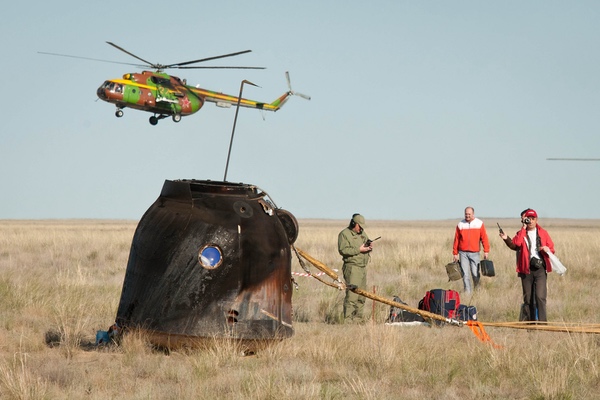 Soyuz crew recovery operations in 2010. Nearly three decades earlier, American satellites photographed the recovery of a spacecraft near the launch site after the on-pad abort. (credit: Roscosmos) |
In Washington, DC, throughout September 1983, intelligence analysts gathered data indicating that a Soviet rocket launch was imminent, and over several weeks they used satellite photography to piece together what was happening. That photography was viewed by analysts at the National Photographic Interpretation Center, (NPIC), often referred to as “enpic.” A special NPIC facility in the Washington, DC suburbs of Virginia housed what was known as the Priority Exploitation Group, or PEG. PEG was where analysts looked at data almost as soon as it was beamed back from space. According to an intelligence cable, satellite photography indicated that “a space launch vehicle is on the pad.” This implied that a launch was imminent because the Soviet Union, unlike the United States, didn’t dawdle with launch operations outside—they prepared their rockets and spacecraft indoors, horizontally, then rolled them out and erected them, launching usually within a few days of pointing them toward the sky.[9]
But there was another key clue in the photography: “The presence of an escape tower atop the payload indicates that it is an SL-04 launch vehicle with a Progress/Soyuz payload,” an analyst wrote in a cable that was not declassified until decades later. Robotic spacecraft did not have escape towers. But although the launch was sure to happen soon, the brief report stated that “No activity is observed at the reviewing stand at Tyuratam ESV [Earth Satellite Vehicle] tracking facility.” So, the launch was going to happen soon, but there were no crowds assembling to watch it when the American satellite flew overhead.
Soon after the rocket blew up, an NPIC analyst issued another report on a “probable launch failure” at Launch Site A1. The report stated that the Soyuz launch vehicle, which the intelligence community had designated the SL-04, was no longer on the pad where it had been observed in previous imagery. But there was something more: “The service/support arms at the launch pad are in the lowered position and the overall launch pad area and flame bucket are heavily darkened. Numerous pieces of probable debris are scattered throughout. A recovery area for the probable Soyuz spacecraft is approximately 2 nautical miles (3.7 kilometers) northeast of launch site A1.”[10]
A US reconnaissance satellite had photographed the scene relatively soon after the accident, because the report went on to say that “The probable Soyuz spacecraft, partial remains of the escape tower, one Hook and three Hip helicopters, a special recovery vehicle, and one bus are at the recovery area.”
| Although imagery satellites provided a tremendous amount of data about many Soviet Cold War activities, they were probably not how the CIA was initially tipped off about the Soyuz failure. |
Another NPIC report soon followed, stating that “the flame bucket, launch pad, and service/support arms are heavily charred. Debris, probably from the launch vehicle, is scattered on the floor of the flame bucket. The destruction of the SL-04 vehicle at Launch Site A1, and severe burning of the launch pad area and support mechanism may have rendered the site inoperable. However, the full extent of launch pad damage, and the operational status of the site cannot be determined at this time.”[11]
The report also noted that the only other pad at Baikonur capable of launching a Soyuz rocket, Launch Site B1, was at the time “undergoing extensive refurbishment.” The Soviets, it seemed, were no longer able to launch a replacement crew to the Salyut space station.
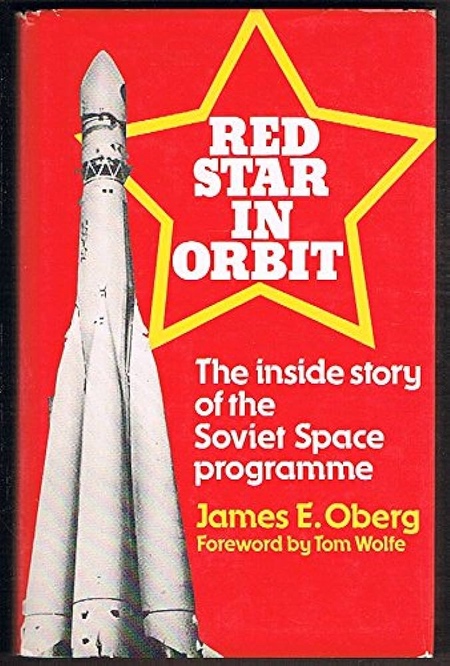 James Oberg wrote the best-selling book Red Star in Orbit in 1981 and closely followed the Soviet space program at that time. He had been expecting a Soyuz launch in fall 1983, but accidentally learned that it had failed. (credit: George G.Harrap & Co Ltd) |
Although imagery satellites provided a tremendous amount of data about many Soviet Cold War activities, and in many ways were the most powerful and prolific intelligence tools that the United States intelligence community possessed, they were far from the only tools in the toolbox and were probably not how the CIA was initially tipped off about the Soyuz failure. The satellites, after all, were in low orbits and only passed over Baikonur once or twice a day. But the United States had other satellites, in much higher orbits, with large antennas pointed down at Baikonur and other Soviet launch sites. Their mission was to listen in on the signals that Soviet rockets broadcast down to the ground during flight, as well as any commands that might be sent to the rockets. They could also pick up the communications at the launch sites, and an increase in communications was a clear tip-off that a launch was about to occur, prompting the Americans to turn on other sensors or even to launch aircraft capable of tracking rockets and missiles in flight from over the Pacific Ocean. American intelligence sensors had probably been tipped off that a countdown was progressing, and analysts knew something had happened when no launch occurred.
The Soyuz explosion probably also registered on seismic and infrasound detectors that the United States employed primarily to listen for evidence of atomic tests, but could also detect other large explosions. But probably the best source of real-time data was an Air Force Defense Support Program (DSP) infrared missile warning satellite in geosynchronous orbit. The DSP had a large infrared telescope that was designed to detect the heat of Soviet ICBM and rocket exhausts and it almost certainly detected the explosion of the Soyuz.
This was not the first time that American reconnaissance satellites had observed a major launch accident at the launch site. The most notable example was in July 1969 when a huge Moon rocket known as the N1, but called “the J vehicle” by the CIA because it launched from Complex J, rose off its pad a few hundred meters and then fell back onto it and exploded with the force of a small nuclear bomb. The devastation from that failure was readily visible on reconnaissance satellite imagery.[12]
By September 30, 1983, American reconnaissance satellites detected more recovery operations at Launch Site A1. “Two special recovery vehicles were in the recovery area,” an NPIC report noted. “One vehicle was associated with the retrieval of the spacecraft, and the other was for personnel transport. The probable command module of the spacecraft was on the ground near the vehicles, and the possible recovery parachute was nearby. In addition, one Hook helicopter, three Hip helicopters, and one bus were in the area.” But another American satellite overflew Baikonur and the report noted that “Approximately four hours later at 0945 Zulu [time], the area had been vacated of all equipment.”[13]
James Oberg had become well-known for exposing hidden secrets about the Soviet space program with the 1981 publication of his book Red Star in Orbit, and he remembers how he found out about the Soyuz launch pad accident. In addition to understanding trajectories and launch windows, Oberg had cultivated sources that would keep him informed of Soviet space developments. He was following the Salyut program and its woes closely. “Quite by coincidence, I had made a visit to Cheyenne Mountain a few months earlier, and made the acquaintance of a Canadian officer serving there. We stayed in contact regarding the ‘private space sleuthing’ I was involved in, that he was fascinated by,” Oberg recounted in an email three decades later.
Oberg had suspected that the Soviets planned a Soyuz launch to send a new crew to Salyut. He had produced tables indicating when the optimal launch time would be. He put these in a “cosmogram” on September 19 that he physically mailed out to various people. “I listed ‘appropriate windows for a Soyuz swap mission’ on October 5 and 7, and added that ‘the next long duration crew is to consist of Titov, Strekalov, and the backup to Serebrov on Soyuz T-8.’”
Around September 28, nearing the expected launch date, Oberg telephoned his NORAD acquaintance to discuss the reasons for expecting a launch “any day now.” Oberg said that the man he was talking to “paused, then in a low voice announced, ‘It’s already happened.’” Oberg was surprised. “I made sure that's what he had said, and couldn’t get any further details about what clearly seemed to be a Soyuz launch abort. But that was enough.”
| Oberg telephoned his NORAD acquaintance to discuss the reasons for expecting a launch “any day now.” Oberg said that the man he was talking to “paused, then in a low voice announced, ‘It’s already happened.’” |
Oberg then called up one of the people who had helped him with his book years earlier, Charles Vick. However, Vick does not recall being called by Oberg on this subject and insists that it was not him. Whoever it was, Oberg said that he “very carefully told him that I had been given a hint that the launch may have failed, but we could not release that information because it could lead back to the source. I told him to ‘sound out his own DoD contacts in Washington’ about what they might volunteer about the status of the expected launch. I very explicitly told him NOT to claim there was a report of a launch failure. He agreed.”
According to Oberg, his contact’s first call was to Thomas O’Toole, a reporter at The Washington Post. “And he asked with all his finesse, ‘What have you heard about any Soyuz manned launch failures recently?’” The reporter had not heard of any, “but of course jumped on the story,” Oberg remembered. “Criminy! This was exactly what I did NOT want to happen,” Oberg said.
O’Toole’s story made the front page of The Washington Post on October 1. Titled “Cosmonauts Safe As Soviet Rocket Explodes on Pad,” O’Toole had almost no information about the accident itself, and most of his article could have been based upon independent sources with knowledge of the general details of the Soyuz spacecraft and rocket. The only bit of actual news in his article was that a failure had occurred, although somehow O’Toole learned that the failure had happened on the pad, and not in the early minutes of flight.[14] Based on the available evidence, it appears that O’Toole’s article was the result of an accidental leak rather than a deliberate leak from the Pentagon to embarrass the Soviet Union.
“Pretty soon Aviation Week also shook some confirmation loose from the Pentagon, and once that happened my own source was no longer under threat of trace-back,” Oberg explained. The Aviation Week article appeared on October 3.[15]
“Then it became a question of seeing who was on board, and what the abort details were,” Oberg added. “For awhile we didn’t even know if it was a crew of two or of three, but soon Phil Clark’s Law was confirmed about how Salyut altitude determined whether the weight of a third man could be added.” Clark was a UK-based space sleuth who also followed the Soviet space program.
“Those were the days!” Oberg remembered.[16]
The Soviet government only reluctantly admitted that it had experienced a launch problem, but provided few details. The American government continued to milk the event for all the propaganda value that it could, focusing attention on the two cosmonauts who were “stranded” aboard Salyut 7. News of a propellant leak on board Salyut-7 had caught the attention of Western observers who probably overrated the danger of the situation.[17] The concern was that because of the launch abort, the main crew already on Salyut-7, didn’t have a safe Soyuz to return home. Newsweek magazine, reporting on the rumors of the aborted launch, compared the situation to Apollo 13 noting that “two Soviet cosmonauts might be stranded in their damaged Salyut 7 space station, with time running out for a safe trip home.”[18] Those claims, it turned out, were overblown.
Whereas the Americans had very cryptic information about what had happened, the Soviets had reams of data, and of course eyewitness reports. An investigation showed that there had been a problem in one of the side boosters (Blok V) of the Soyuz rocket. Apparently, a valve that controlled the delivery of fuel had been incorrectly installed. Due to incorrect operation of the valve, fuel began to rush into the main engine’s turbopump assembly too fast, and the turbines began to spin uncontrollably. One of the blades literally tore off, creating a spark, which in turn, started a fire at the base of the rocket. The fire spread all along the base of the rocket and rapidly began to rise all around the rocket, moving dangerously upwards, higher and higher, “almost to the top of the rocket,” in the words of journalist Mikhail Rebrov, who was reporting on the launch from a viewing stand.
The launch escape system undoubtedly saved the crew’s life since the rocket quickly collapsed and exploded because of the fire. A reconstruction of the sequence of events leading to the abort illustrates the quick thinking of ground controllers in firing that escape system.
| Shevchenko received Shumilin’s command first and immediately pressed a button on his console. In order for the launch escape system to fire, his compatriot, Mochalov had to push his button within a five second period. Luckily he did that—with one whole second to spare. |
Two men were responsible for launch operations that day. Aleksey Shumilin, an officer in the Strategic Rocket Forces who was head of the 1st directorate at Baikonur, was in charge of launch operations for the “customer”. Aleksandr Soldatenkov, a senior designer from the organization that manufactured the rocket, was in charge of launch operations from the “vendor” side. Both were veterans of dozens of Soyuz launches so they were familiar with emergency protocols, but neither had ever experienced such an emergency. Yet both acted exactly as they had been trained to do and saved the lives of the crewmembers.
Both Shumilin and Soldatenkov were in an underground bunker not far from the rocket. Both had their eyes glued to periscopes focused on the rocket. At T minus 1 minute 48 seconds, a fire initially began at the base of the rocket.[19] Shumilin and Soldatenkov were unaware of this because the fire was still not yet visible, and they were going through the routine set of commands leading up to a standard Soyuz launch. About a minute before launch, as soon as the command “Pressurization” was issued, the fire began to appear at the bottom of the rocket. Within six seconds of seeing this fire, Shumilin instinctively knew that he had to issue a command to fire the launch escape system. Using a regular landline telephone he called out: “It’s a fire! Dnestr! Dnestr! Fire at the pad!” Within seconds, Soldatenkov did the same thing. Using a second telephone, he simply said “Dnestr.”[20]
What these two men were doing was issuing a special code, in this case the Russian word “Dnestr” (the name of a famous river in Eastern Europe and Ukraine also often spelled “Dniestr”) that would initiate a sequence of events to fire the launch escape system. For each Soyuz launch, ground controllers were assigned a unique word to denote an abort. But because they didn’t want to have an accidental abort, there were safeguards built into the system. Two men (in this case Shumilin and Soldatenkov) had to each individually issue the codeword into their telephones. At the other end of their landlines were two junior officers who were standing by at the Saturn command station about 30 kilometers from the launch pad (at Baikonur’s Site 23). The two men (in this case Senior Lieutenant M. G. Shevchenko and Lieutenant A. V. Mochalov) were stationed in two separate rooms and could not see each other. When Shumilin and Soldatenkov issued the “Dnestr!” abort command, they spoke directly but individually to the two men at the Saturn station. Shevchenko received Shumilin’s command first and immediately pressed a button on his console. In order for the launch escape system to fire, his compatriot, Mochalov had to push his button within a five second period. Luckily he did that—with one whole second to spare. Their combined input successfully issued a radio command to fire the launch escape system on the Soyuz, located 30 kilometers away.[21]
Titov later recalled that besides the actions of Shumilin and Soldatenkov, there was one more reason that he thinks he and Strekalov survived: the wind that night. As the flames from the bottom of the rocket began to rise to the top of the rocket, they threatened to engulf the nosecone. But because it was so windy, the fire was at an angle, saving the Soyuz. Furthermore, if the fire had been vertical, there would have a been a low temperature plasma sheath which would have inhibited reception of the radio command to fire the launch escape system. If that signal hadn’t come in at the time it did, the crew would have most certainly perished.
For a long time Titov genuinely believed that his fate was jinxed—after all, neither of his two space missions had gone well. When he was cycled back into training, he was assigned to fly the first long duration mission to the Mir space station in 1987. Yet just days before his launch, his flight engineer was grounded and the backup crew launched instead. Titov finally got his successful mission in December 1987 when he arrived at Mir. He and his compatriot Musa Manarov spent a record year in space on board the station. Titov later became the second Russian cosmonaut to fly on the Space Shuttle. He retired from active cosmonaut duty in 1998 after a total of four space missions. Strekalov flew five times in space before retiring in 1995. He passed away in 2004 at the age of 64.
In 1984, ground controllers Shumilin and Soldatenkov were both given the highest national award for civilians, the “Hero of Socialist Labor,” for their part in saving the lives of the Soyuz crew. Shumilin later went to on to serve as commander of the Baikonur Cosmodrome during the 1990s.
The pad at Site 1, the same one which launched Sputnik and Gagarin, was repaired within seven months and a successful launch carried out in June 1984. In the interim, the Soviets used the second Soyuz pad at Site 31 for Soyuz and Progress missions. The Site 1 pad is now due for retirement, more than 65 years after ushering in the Space Age.
The United States continued to monitor the Baikonur launch range and soon another NPIC report noted that “At least four vehicles including a probable truck-mounted crane are working in the flame bucket to remove debris” and four other vehicles were at the rim of the flame bucket.[22]
By late September 1983, NPIC’s imagery interpreters noted that post-accident operations were in progress at the launch pad, with two truck-mounted cranes assembling a larger rail-mounted crane on the apron of the launch pad. “The presence of the large crane indicates that the gantry service tower on the launch pad will be dismantled for refurbishment or replacement.”[23]
| The Soviet space program eventually recovered and Soyuz spacecraft began flying again. But it would be many years before the details of this 1983 accident would eventually become known. |
On October 3, 1983, NPIC issued another report, and the subject indicated that NPIC must have received questions about the status of Soviet space launch capabilities in general. It stated that four of six space launch pads at Baikonur, and three at the Soviet launch complex at Plesetsk, were still operational. The report also revised an earlier NPIC claim: Launch Site B1, which also launched Soyuz rockets, was about to be refurbished, but was still capable of operations. Major gantry components had been brought in and stockpiled along the approach to the pad, but were not blocking the rail line. Considering the recent explosion at Launch Site A1, NPIC analysts speculated that “the refurbishment plans… may be delayed.”[24]
Shortly thereafter, NPIC produced another report that stated that “the umbilical tower and the launch vehicle stabilization arms have been removed from the launch pad. The launch pad aperture ring and the two large service arms remain in place. However, their removal and replacement probably also will be necessary. This major repair activity closely parallels the 1979–80 pad refurbishment which took approximately 15 months to complete.”
The Soviet space program eventually recovered and Soyuz spacecraft began flying again. But it would be many years before the details of this 1983 accident would eventually become known, and many more years before live broadcasts of Russian space launches—successful and otherwise—became the norm.
ReferencesNote: we are using a new commenting system, which may require you to create a new account.